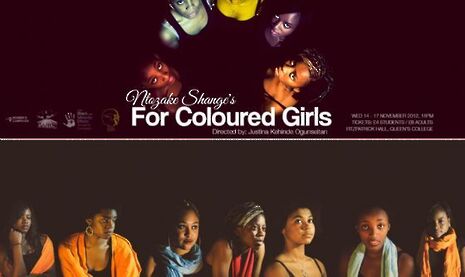Theatre: For Colored Girls
Rivkah Brown is enchanted by this all-black, all-female, poetic piece of theatre

The sheer poetry of For Colored Girls (who have considered suicide when the rainbow is enuf) begins at its title, and doesn’t stop. The 1975 choreopoem by African-American poet Ntozake Shange is best described as a stream of words structured around movement and music, and deftly sidesteps the pigeonholes of "spoken word", "interpretative dance" or, worst of all, "musical" - kudos for which surely go to the band, whose improvised velvety jazz rhythms give the production a beautiful elasticity. Justina Kehinde Ogunseitan has been masterful in her dealing with Shange’s difficult and slippery poem-cum-play, loosening and tightening her grip alternately, and giving just the right degree of emotional intensity whilst allowing the actors to relax into their roles.
The play features seven women, identified only by the colour of their long silk skirts - Red, Orange, Yellow, Green, Brown, Purple and Blue - and functioning not only as individuals, but interchangeable consciousnesses, even the collective voice of black womanhood. Certain personalities are strikingly well-defined, such as that of Blue (played by Ogunseitan herself), the daughter of slaves, defiant and pugnacious; or Tasila Banda’s Red, a feisty yet miserably world-weary prostitute. The palette of personae is indeed as rich as the rainbow itself, and Ogunseitan has done well to flesh these out convincingly.
The poetry in which these women tell their stories (the play is made up of 20 such poems) is enriched by its sensitive delivery: Isabel Adomakoh Young indulges us with her tale of Yellow’s lost virginity, and her enjoyment of her performance is evident. Never once do we taste, despite the artificiality of the mode, any tang of insincerity: on the contrary, the emotional truth of Yellow’s contraction of HIV from her cheating boyfriend rings out all the louder for its expression in verse form. The poetry gets to something deeper, weaving the banalities of conversation into a richer mode of expression that is at first striking, but then so incredibly lifelike.
One issue I felt was handled with particular faithfulness and sensitivity was that of rape: having been disappointed by Lauren Steele’s recent Did You Say No Though?, the vision of Blue raped by a man "suffering from latent rapist bravado" is a breath of fresh air, reviving what is often a tired subject for theatre. Ogunseitan is careful not to over-egg her portrayal, pushing her own character to the precipice of despair before reeling her swiftly back in. Nor does the director grind the play’s feminist axe too hard, either, allowing the poetry to speak for itself: "She could’ve been slapped upside the head or verbally challenged, but she never was."
The play moves to a climactic, perhaps shamanic "laying on of hands". If any scene in the play has the potential to seem awkward and contrived, surely it is this: yet it is here that the seeds Ogunseitan has sewn throughout the production come to fruition, and we see the full potentiality of Shange’s women as African-Americans, as Muses, even as Goddesses. Finally, we see that Ogunseitan has done what Tyler Perry’s melodramatic 2010 Hollywood adaptation failed to do: justice to the raw energy and spiritual womanhood of Shange’s play.
For Colored Girls runs at the Fitzpatrick Hall, Queens' College, at 11pm until Saturday
 News / Fitz students face ‘massive invasion of privacy’ over messy rooms23 April 2024
News / Fitz students face ‘massive invasion of privacy’ over messy rooms23 April 2024 News / Climate activists smash windows of Cambridge Energy Institute22 April 2024
News / Climate activists smash windows of Cambridge Energy Institute22 April 2024 News / Copycat don caught again19 April 2024
News / Copycat don caught again19 April 2024 Comment / Gown vs town? Local investment plans must remember Cambridge is not just a university24 April 2024
Comment / Gown vs town? Local investment plans must remember Cambridge is not just a university24 April 2024 News / Emmanuel College cuts ties with ‘race-realist’ fellow19 April 2024
News / Emmanuel College cuts ties with ‘race-realist’ fellow19 April 2024




